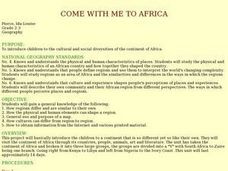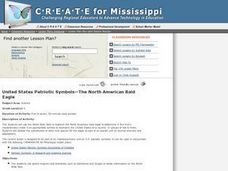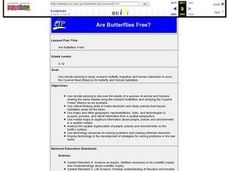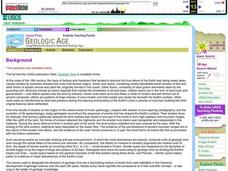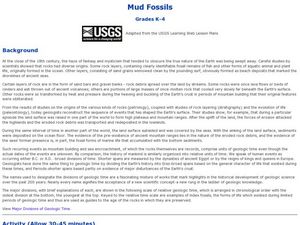Curated OER
Come With Me To Africa
Students are introduced to the geography of the continent of Africa. They conduct Internet research, explore maps and identify animal species and a variety of human cultures for a sampling of African countries. Students create graphs,...
Curated OER
Natural Inquirer
Students interview wildlife experts to gain information needed to research and write a report about an aquatic plant or animal affected by climate change.
Curated OER
Endangered Species Furniture Project
Students work in groups to research an endangered species. They then refinish and paint a piece of furniture and incorporate facts and references about the animal they have researched.
Curated OER
Mother Nature's Laboratory
Students research how various plants and animals adapt over time to specific habitats and for specific purposes. Students produce a pictorial report on an example of an animal or plant's adaptation.
Curated OER
Gale's Curriculum
Seventh graders develop an understanding of Southeastern Asian culture. They increase knowledge of world geography in relation to Southeast Asian countries. Students research a variety of Southeast Asian animals and habitats to be used...
Curated OER
Mars rovers' Next Stop: IMAX
Learners read an article and discuss it. In this Mars rover lesson students complete an activity that allows them to see things through a different viewpoint.
Curated OER
US Patriotic Symbols: The North American Bald Eagle
Students research the North American bald eagle to determine if this bird's characteristics make it an appropriate symbol to represent the United States as a country. They debate the substitution of other bird species for the eagle.
Curated OER
Are Butterflies Free?
Students use remote sensing to study monarch butterfly migration and human interaction to save the Oyamel forest (Mexico) for butterfly and human habitation.
Curated OER
Looking Into the Mirror
Young scholars survey the impact of racial, cultural, and/or socio-economic intolerance in their own lives in relation to other individuals. They develop written and oral proposals to solve inequality and intolerance on a local, state,...
Gwinnett County Public Schools
Analysis of the Tuck Everlasting and The Birchbark House Text Exemplars
Looking to introduce some text-based questions into your ELA lessons? Practice the kinds of skills the Common Core demands with the seven text-based questions and the essay prompt provided here. Designed to be a three-day lesson, day one...
Sea World
Endangered Species
Study different endangered species with several activities that incorporate math, science, language arts, and research strategies. A great addition to your lesson on conservation or Earth Day.
Montana State University
One Mountain, Many Cultures
Americans may think of Mount Everest as a region dedicated to adventurous hikers, but many cultures have flourished there! Learners read informative books, watch videos, participate in classroom discussion, analyze folk tales, and...
Curated OER
Rain Forests: A Disappearing Act?
Students examine and locate rainforests on maps, and research the patterns of their destruction. They develop a bar graph of rainfall and temperature data, write a journal entry, and research the people, animals, and plants/products of...
Curated OER
Geologic Age
Students investigate radioactivity as a tool for measuring geologic time and how geologists use this information to determine the absolute age of rocks or minerals.
Curated OER
Cloudy With a Chance of Meatballs
Fourth graders participate in a play to work on seeing events from a different perspective. Some of them are reporters, some cameramen and women, and others are interviewed. They put themselves in the shoes of the people in the book...
Curated OER
Exploring the Biomes of South America
Sixth graders complete a five-week unit investigating the eight major biomes of South America. They conduct Internet research, collect short-term and long-term climate data, and create a HyperStudio slideshow stack about a selected biome...
Curated OER
Mud Fossils
Young scholars observe real fossils. In this science lesson, students make their own mud fossils by pressing material into the mud and letting it dry in the sun for 3-4 days. Young scholars then get the fossils out displaying their mud...
Curated OER
What is the Evidence for Evolution?
Learners identify one object that would tell the story of their lives. In groups, they determine what can and cannot be told from objects left behind. After watching a video, they compare and contrast chicken bones to human bones. To...
Curated OER
Oceans-Coral Reefs
Second graders investigate coral reefs. In this oceanology lesson plan, 2nd graders discuss what constitutes a coral reef and the wildlife that lives there. Students watch a video about coral reefs and take an online quiz.
Curated OER
From Wolf to Dog
Students explain how dogs evolved from wolves based on the video. In this biology lesson, students research about breeding animals for specific traits. They interview dog owners and create a presentation about the dog.
Curated OER
Voices of History: Relating Historic Events to Current Events
Students discuss the current events affecting the country today. In groups, they relate a historical event to a current event. They research and present the point of view of a historical figure in an interesting way. They compare and...
Curated OER
California Biodiversity
Students examine several maps of California exhibiting features such as precipitation, topography, and vegetation. They look for patterns that might be the source of or influence biodiversity in different regions. They pay particular...
Curated OER
African American Traditions: Cameroonian and African-American Folktales
Young scholars compare Cameroonian and African-American folktales. In this folktales lesson plan, students participate in a jigsaw activity that requires them to read "The Owl Never Sleeps as Night," "Why the Lizard Often Nods," "Tappin,...
Curated OER
Galapagos Adaptations
Students examine photographs of closely related species found in the Gal??pagos environment, observe differences and similarities between species, and form hypotheses about species differences and the relationship to the environment of...


